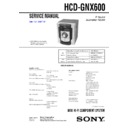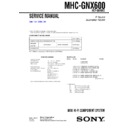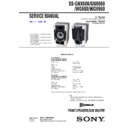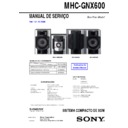Sony HCD-GNX600 / MHC-GNX600 Service Manual ▷ View online
HCD-GNX600
E Model
Australian Model
SERVICE MANUAL
MINI HI-FI COMPONENT SYSTEM
SPECIFICATIONS
Ver. 1.2 2007.12
– Continued on next page –
• HCD-GNX600 is the Amplifier,
CD player, tape deck and tuner
section in MHC-GNX600.
section in MHC-GNX600.
Model Name Using Similar Mechanism
HCD-GNX800
CD
CD Mechanism Type
CDM74KFS-F1BD81A
Section
Base Unit Name
BU-F1BD81A
Optical Pick-up Name
KSM-215DCP/C2NP
TAPE
Model Name Using Similar Mechanism
HCD-GNX800
Section
Tape Transport Mechanism Type
CWN42FF601
Amplifier section
The following are measured at
120 V, 220 V, 240 V AC,
50/60 Hz
50/60 Hz
Front speakers
DIN power output (rated)
DIN power output (rated)
130 + 130 watts
(6 ohms at 1 kHz, DIN)
(6 ohms at 1 kHz, DIN)
Continuous RMS power output (reference)
160 + 160 watts(6 ohms at 1 kHz,
10% THD)
10% THD)
Sub woofer
Continuous RMS power output (reference)
Continuous RMS power output (reference)
200 watts
(4 ohms at 100 Hz,
10% THD)
(4 ohms at 100 Hz,
10% THD)
TV (AUDIO) IN (phono jack)
voltage 250 mV,
impedance 47 kiloohms
impedance 47 kiloohms
MIC (phone jack)
sensitivity 1 mV,
impedance 10 kiloohms
impedance 10 kiloohms
Outputs
PHONES (stereo mini jack)
PHONES (stereo mini jack)
accepts headphones of
8 ohms or more
8 ohms or more
FRONT SPEAKER/SUB WOOFER OUT
Use only the supplied
speaker
speaker
Disc player section
System
Compact disc and digital
audio system
audio system
Laser
Semiconductor laser
(
(
λ
=780 nm)
Emission duration:
continuous
continuous
Laser Output
Max. 44.6
µ
W*
* This output is the value
measured at a distance of
200 mm from the objective
lens surface on the Optical
Pick-up Block with 7 mm
aperture.
measured at a distance of
200 mm from the objective
lens surface on the Optical
Pick-up Block with 7 mm
aperture.
Frequency response
2 Hz – 20 kHz (
±
0.5 dB)
Wave length
780 – 790 nm
Signal-to-noise ratio
More than 90 dB
Dynamic range
More than 90 dB
Tape deck section
Recording system
Recording system
4-track 2-channel stereo
Frequency response
50 – 13,000 Hz (
±
3 dB),
using Sony TYPE I tape
Sony Corporation
Audio Business Group
Published by Sony Techno Create Corporation
Published by Sony Techno Create Corporation
9-887-199-03
2007L02-1
© 2007.12
© 2007.12
2
HCD-GNX600
Notes on chip component replacement
• Never reuse a disconnected chip component.
• Notice that the minus side of a tantalum capacitor may be
• Notice that the minus side of a tantalum capacitor may be
damaged by heat.
Flexible Circuit Board Repairing
• Keep the temperature of soldering iron around 270˚C
during repairing.
• Do not touch the soldering iron on the same conductor of the
circuit board (within 3 times).
• Be careful not to apply force on the conductor when soldering
or unsoldering.
CAUTION
Use of controls or adjustments or performance of procedures
other than those specified herein may result in hazardous
radiation exposure.
other than those specified herein may result in hazardous
radiation exposure.
This appliance is classified as
a CLASS 1 LASER product.
This label is located on the rear
exterior.
a CLASS 1 LASER product.
This label is located on the rear
exterior.
SAFETY-RELATED COMPONENT WARNING!!
COMPONENTS IDENTIFIED BY MARK
0
OR DOTTED LINE WITH
MARK
0
ON THE SCHEMATIC DIAGRAMS AND IN THE PARTS
LIST ARE CRITICAL TO SAFE OPERATION. REPLACE THESE
COMPONENTS WITH SONY PARTS WHOSE PART NUMBERS
APPEAR AS SHOWN IN THIS MANUAL OR IN SUPPLEMENTS
PUBLISHED BY SONY.
COMPONENTS WITH SONY PARTS WHOSE PART NUMBERS
APPEAR AS SHOWN IN THIS MANUAL OR IN SUPPLEMENTS
PUBLISHED BY SONY.
Unleaded solder
Boards requiring use of unleaded solder are printed with the lead
free mark (LF) indicating the solder contains no lead.
(Caution: Some printed circuit boards may not come printed with
the lead free mark due to their particular size.)
free mark (LF) indicating the solder contains no lead.
(Caution: Some printed circuit boards may not come printed with
the lead free mark due to their particular size.)
: LEAD FREE MARK
Unleaded solder has the following characteristics.
• Unleaded solder melts at a temperature about 40
°
C higher than
ordinary solder.
Ordinary soldering irons can be used but the iron tip has to be
applied to the solder joint for a slightly longer time.
Soldering irons using a temperature regulator should be set to
about 350
Ordinary soldering irons can be used but the iron tip has to be
applied to the solder joint for a slightly longer time.
Soldering irons using a temperature regulator should be set to
about 350
°
C.
Caution: The printed pattern (copper foil) may peel away if
the heated tip is applied for too long, so be careful!
the heated tip is applied for too long, so be careful!
• Strong viscosity
Unleaded solder is more viscous (sticky, less prone to flow)
than ordinary solder so use caution not to let solder bridges
occur such as on IC pins, etc.
than ordinary solder so use caution not to let solder bridges
occur such as on IC pins, etc.
• Usable with ordinary solder
It is best to use only unleaded solder but unleaded solder may
also be added to ordinary solder.
also be added to ordinary solder.
Tuner section
FM stereo, FM/AM superheterodyne tuner
FM tuner section
Tuning range
FM tuner section
Tuning range
87.5 – 108.0 MHz
Antenna
FM lead antenna
Antenna terminals
75 ohm unbalanced
Intermediate frequency
10.7 MHz
AM tuner section
Tuning range
Latin American models:
Tuning range
Latin American models:
530 – 1,710 kHz
(with the interval set at 10 kHz)
531 – 1,710 kHz
(with the interval set at 9 kHz)
(with the interval set at 10 kHz)
531 – 1,710 kHz
(with the interval set at 9 kHz)
Other models:
531 – 1,602 kHz
(with the interval set at 9 kHz)
530 – 1,710 kHz
(with the interval set at 10 kHz)
(with the interval set at 9 kHz)
530 – 1,710 kHz
(with the interval set at 10 kHz)
Antenna
AM loop antenna
Antenna terminals
External antenna terminal
Intermediate frequency
450 kHz
General
Power requirements
Australian model:
Australian model:
230 – 240 V AC, 50/60 Hz
Argentina model:
220 V AC, 50/60 Hz
Other models:
120 V or 220 – 240 V AC,
50/60 Hz
Adjustable with voltage selector
50/60 Hz
Adjustable with voltage selector
Power consumption
110 watts
Dimensions (w/h/d) (Approx.)
280
×
326
×
385.5 mm
Mass (Approx.)
6.3 kg
Supplied accessories:
Remote Commander (1)
Batteries (2)
AM loop antenna (1)
FM lead antenna (1)
Front speaker pads (8)
Sub woofer pads (4)
Batteries (2)
AM loop antenna (1)
FM lead antenna (1)
Front speaker pads (8)
Sub woofer pads (4)
Design and specifications are subject to change
without notice.
without notice.
3
HCD-GNX600
TABLE OF CONTENTS
1.
SERVICING NOTES
................................................
4
2.
GENERAL
Locating the Controls ......................................................
5
Setting the Clock .............................................................
6
3.
DISASSEMBLY
3-1.
Disassembly Flow ...........................................................
7
3-2.
Side Case, Top Case ........................................................
8
3-3.
Loading Panel ..................................................................
8
3-4.
Front Panel Assy ..............................................................
9
3-5.
Tuner Pack .......................................................................
9
3-6.
Tape Mechanism Deck, MIC Board ................................ 10
3-7.
PANEL Board, IR Board, VOL Board ............................ 10
3-8.
CD Mechanism Deck ...................................................... 11
3-9.
Back Panel, DC FAN (M891) ......................................... 11
3-10. MAIN Board, ADC Board ............................................... 12
3-11. POWER Board, SPEAKER Board .................................. 12
3-12. SMASTER Board ............................................................ 13
3-13. DRIVER Board, SW Board ............................................. 13
3-14. CD Board, Optical Pick-up ............................................. 14
3-15. SENSOR Board ............................................................... 14
3-16. MOTOR (TB) Board ....................................................... 15
3-17. MOTOR (LD) Board ....................................................... 15
3-11. POWER Board, SPEAKER Board .................................. 12
3-12. SMASTER Board ............................................................ 13
3-13. DRIVER Board, SW Board ............................................. 13
3-14. CD Board, Optical Pick-up ............................................. 14
3-15. SENSOR Board ............................................................... 14
3-16. MOTOR (TB) Board ....................................................... 15
3-17. MOTOR (LD) Board ....................................................... 15
4.
TEST MODE
.............................................................. 16
5.
MECHANICAL ADJUSTMENTS
....................... 20
6.
ELECTRICAL ADJUSTMENTS
Deck section .................................................................... 20
CD Section ...................................................................... 21
CD Section ...................................................................... 21
7.
DIAGRAMS .................................................................... 24
7-1.
Block Diagram – CD Section – ...................................... 26
7-2.
Block Diagram – Tape/Tuner Section – ......................... 27
7-3.
Block Diagram – Main Section – ................................... 28
7-4.
Block Diagram – AMP Section – ................................... 29
7-5.
Block Diagram – Display/Power Section – .................... 30
7-6.
Printed Wiring Board – CD Board – .............................. 31
7-7.
Schematic Diagram – CD Board – ................................. 32
7-8.
Printed Wiring Boards – CD Mechanism Sectiom – ...... 33
7-9.
Schematic Diagram – CD Mechanism Section – ........... 34
7-10. Printed Wiring Board – MAIN Board – ......................... 35
7-11. Schematic Diagram – MAIN Board (1/3) – ................... 36
7-12. Schematic Diagram – MAIN Board (2/3) – ................... 37
7-13. Schematic Diagram – MAIN Board (3/3) – ................... 38
7-14. Printed Wiring Board – PANEL Section – ..................... 39
7-15. Schematic Diagram – PANEL Section – ......................... 40
7-16. Printed Wiring Boards
7-11. Schematic Diagram – MAIN Board (1/3) – ................... 36
7-12. Schematic Diagram – MAIN Board (2/3) – ................... 37
7-13. Schematic Diagram – MAIN Board (3/3) – ................... 38
7-14. Printed Wiring Board – PANEL Section – ..................... 39
7-15. Schematic Diagram – PANEL Section – ......................... 40
7-16. Printed Wiring Boards
– MIC,VOL and SPEAKER Boards – ............................ 41
7-17. Schematic Diagram
– MIC,VOL and SPEAKER Boards – ............................ 42
7-18. Printed Wiring Board – ADC Board – ............................ 43
7-19. Schematic Diagram – ADC Board – .............................. 44
7-20. Printed Wiring Board – SMASTER Board (Side A)– ... 45
7-21. Printed Wiring Board – SMASTER Board (Side B)– .... 46
7-22. Schematic Diagram – SMASTER Board (1/2)– ............ 47
7-23. Schematic Diagram – SMASTER Board (2/2)– ............ 48
7-24. Printed Wiring Boards – Power Board – ........................ 49
7-25. Schematic Diagram – Power Board – ............................ 50
7-26. IC Pin Function Description ............................................ 54
7-19. Schematic Diagram – ADC Board – .............................. 44
7-20. Printed Wiring Board – SMASTER Board (Side A)– ... 45
7-21. Printed Wiring Board – SMASTER Board (Side B)– .... 46
7-22. Schematic Diagram – SMASTER Board (1/2)– ............ 47
7-23. Schematic Diagram – SMASTER Board (2/2)– ............ 48
7-24. Printed Wiring Boards – Power Board – ........................ 49
7-25. Schematic Diagram – Power Board – ............................ 50
7-26. IC Pin Function Description ............................................ 54
8.
EXPLODED VIEWS
8-1.
Case (Top), Back Panel Section ...................................... 61
8-2.
Front Panel Section ......................................................... 62
8-3.
Chassis Section ................................................................ 63
8-4.
CD Mechanism Deck Section-1 ...................................... 64
8-5. CD Mechanism Deck Section-2 ..................................... 65
9.
ELECTRICAL PARTS LIST
................................ 66
4
HCD-GNX600
SECTION 1
SERVICING NOTES
NOTES ON HANDLING THE OPTICAL PICK-UP BLOCK
OR BASE UNIT
OR BASE UNIT
The laser diode in the optical pick-up block may suffer electrostatic
break-down because of the potential difference generated by the
charged electrostatic load, etc. on clothing and the human body.
During repair, pay attention to electrostatic break-down and also
use the procedure in the printed matter which is included in the
repair parts.
The flexible board is easily damaged and should be handled with
care.
break-down because of the potential difference generated by the
charged electrostatic load, etc. on clothing and the human body.
During repair, pay attention to electrostatic break-down and also
use the procedure in the printed matter which is included in the
repair parts.
The flexible board is easily damaged and should be handled with
care.
NOTES ON LASER DIODE EMISSION CHECK
The laser beam on this model is concentrated so as to be focused on
the disc reflective surface by the objective lens in the optical pick-
up block. Therefore, when checking the laser diode emission, observe
from more than 30 cm away from the objective lens.
the disc reflective surface by the objective lens in the optical pick-
up block. Therefore, when checking the laser diode emission, observe
from more than 30 cm away from the objective lens.
LASER DIODE AND FOCUS SEARCH OPERATION CHECK
Carry out the “S curve check” in “CD section adjustment” and check
that the S curve waveform is output several times.
that the S curve waveform is output several times.
• MODEL IDENTIFICATION
– Back Panel –
– Back Panel –
MODEL
PART No.
E2 model
2-658-970-0[]
AUS model
2-658-970-2[]
E3 model
2-658-970-3[]
E51 model
2-658-970-4[]
AR model
2-658-970-5[]
• Abbreviation
AR
: Argentina model
AUS : Australian model
E2
E2
: 120 V AC Area in E model
E3
: 240 V AC Area in E model
E51 : Chilean and Peruvian model
PART No.
CHANGE OF THE COMBINED BOARD SUFFIX
Suffix of the Main, Panel and Power combined board was
changed from -12 to -13.
Suffix of the SMASTER combined board was changed from -12
to -13 or -21 (-13 and -21 are the same patterns).
changed from -12 to -13.
Suffix of the SMASTER combined board was changed from -12
to -13 or -21 (-13 and -21 are the same patterns).
Ver. 1.2




